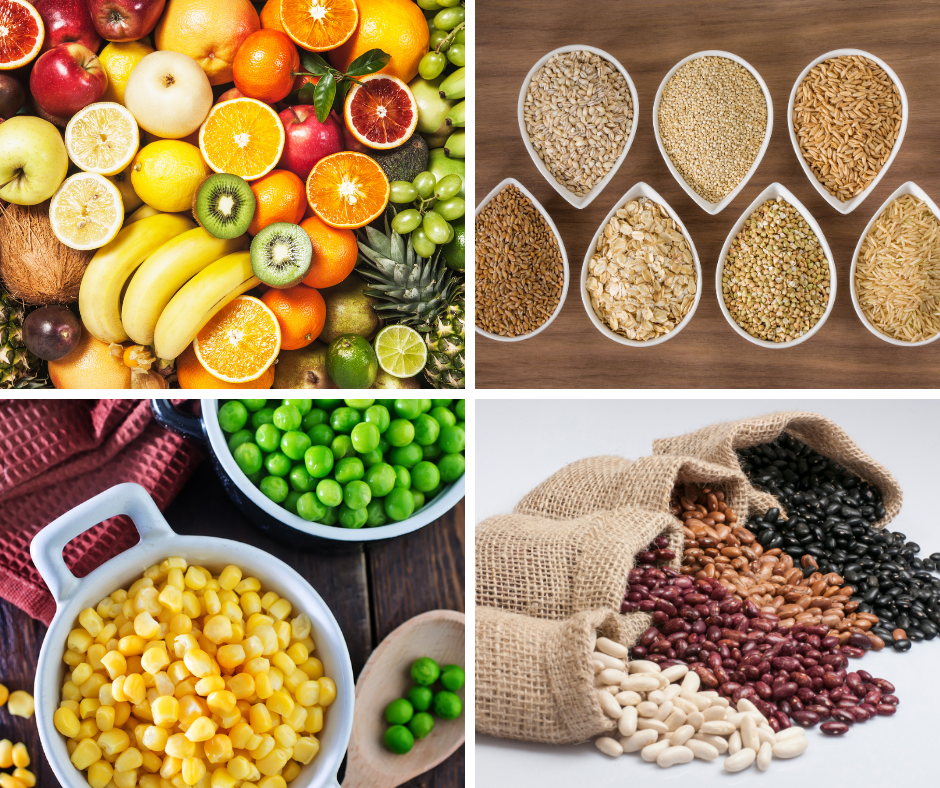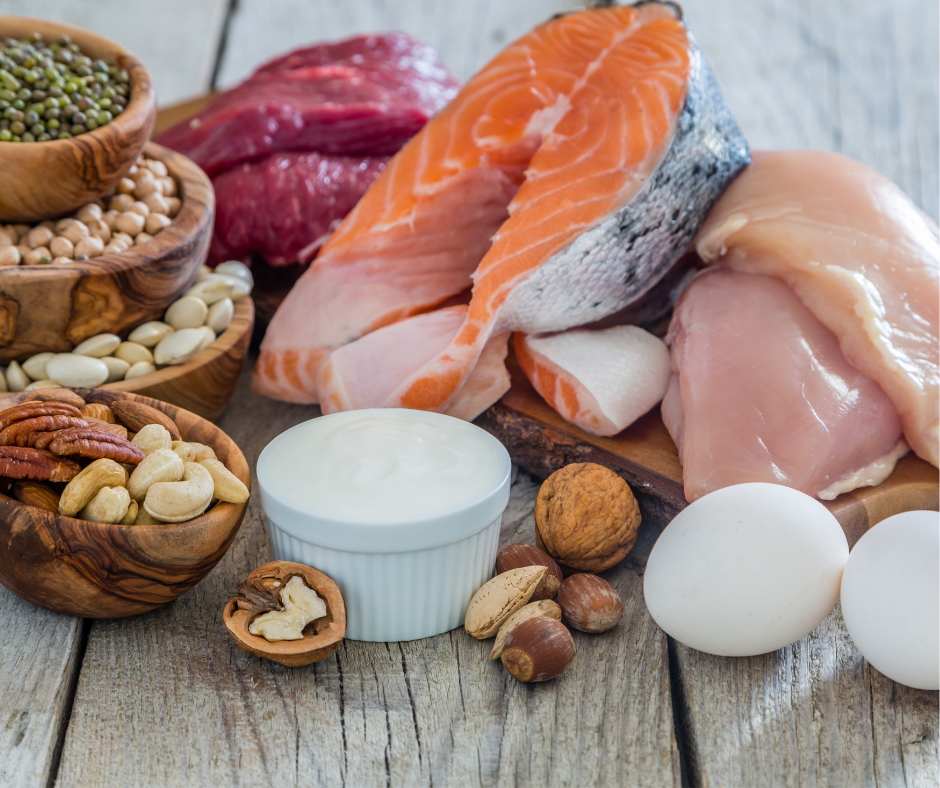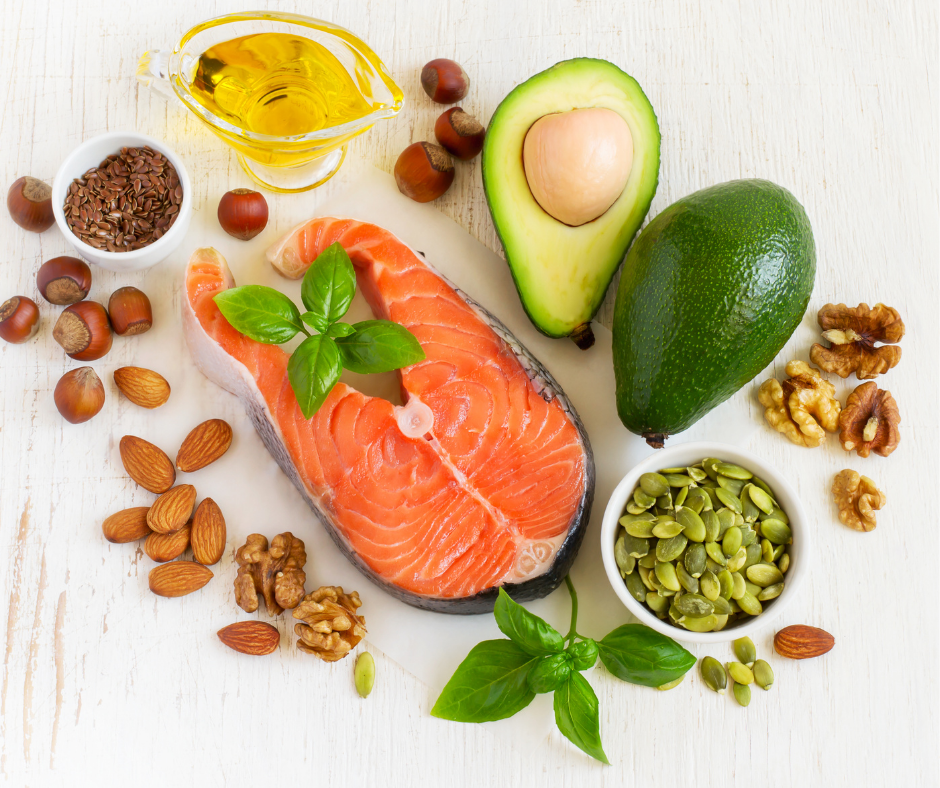
Personalizing Your Plate For Success
With so many “diet trends” and nutrition information out there, it can be hard to figure out what works best for your body. Today we’re going to break down how to personalize your plate to help you meet your body’s needs.
In general, no matter who you are, your plate should be composed of the following components at every meal:
- Non-starchy veggies (usually about ½ your plate)
- Starchy carbohydrates
- Protein
- Healthy Fat
So let’s dive into how to personalize your plate!
Complex Carbohydrates: Non- Starchy Veggies
Nonstarchy veggies of all colors provide a wide array of vitamins, minerals, antioxidants, and phytochemicals that protect your health. They also provide hydration and fiber, which are essential for optimal GI health and weight control.

Any vegetable other than corn, potatoes, and peas falls into this category! Some examples:
- Artichoke/ hearts
- Asparagus
- Beets
- Brussels sprouts
- Broccoli
- Cabbage
- Carrots
- Cauliflower
- Celery
- Cucumber
- Eggplant
- Green beans
- Leafy greens e.g. collard, kale, mustard, turnip, bok choy, kohlrabi
- Jicama
- Leeks
- Mushrooms
- Okra
- Onions
- Peppers
- Radishes
- Snap peas
- Sprouts
- Summer squash
- Spaghetti squash
- Tomato
- Turnips
- Water chestnuts
- Zucchini
Don’t forget about herbs and spices! Dried and fresh herbs and seasonings also fit into this category. They also make your meal more flavorful and exciting! Including, but not limited to:
- allspice (Pimenta dioica)
- anise (Pimpinella anisum)
- bay leaf (Laurus nobilis)
- basil (Ocimum basilicum)
- black cumin (Nigella sativa)
- black mustard (Brassica nigra)
- black pepper (Piper nigrum)
- brown mustard (Brassica juncea)
- caraway (Carum carvi)
- cardamom (Elettaria cardamomum)
- cayenne pepper (Capsicum annuum)
- celery seed (Apium graveolens, variety dulce)
- chili pepper (Capsicum species)
- chives (Allium schoenoprasum)
- cilantro (Coriandrum sativum)
- cinnamon (Cinnamomum verum)
- clove (Syzygium aromaticum)
- coriander (Coriandrum sativum)
- cumin (Cuminum cyminum)
- curry
- dill (Anethum graveolens)
- fennel (Foeniculum vulgare)
- ginger (Zingiber officinale)
- horseradish (Armoracia rusticana)
- marjoram (Origanum majorana)
- nutmeg (Myristica fragrans)
- oregano (Origanum vulgare)
- paprika (Capsicum annuum)
- parsley (Petroselinum crispum)
- peppermint (Mentha ×piperita)
- poppy seed (Papaver somniferum)
- rosemary (Rosmarinus officinalis)
- sage (Salvia officinalis)
- savory (Satureja hortensis and S. montana)
- sesame (Sesamum indicum)
- star anise (Illicium verum)
- spearmint (Mentha spicata)
- thyme (Thymus vulgaris)
- turmeric (Curcuma longa)
- vanilla (Vanilla planifolia and V. tahitensis)
- wasabi (Eutrema japonicum)
- white mustard (Sinapis alba)
How much? At least 2 cups of non-starchy veggies per meal
Complex Carbohydrates: Starchy

Complex carbohydrates fuel your body with energy and are also a source of vitamins, minerals, and fiber! How much you need depends on your activity level and current health status. Your best options for complex carbohydrates:
- Starchy veggies are a great choice here, such as corn, potatoes, and peas!
- All types of fruit, including fresh, frozen, and canned fruit, is a win! You could also substitute 100% fruit juice as well.
- Whole grains such as quinoa, brown rice, wild rice, whole wheat, oats, etc.
- Beans(Pulses) – all types, including canned and cooked from scratch, are a great option. In addition to providing 30grams or more complex carbohydrates per serving, they also provide around 6-8 grams of protein. Some beans such as lentils and soybeans have even higher amounts of protein, approximately 15-20 grams per serving.
How much? In general, we want healthy complex carbohydrates to make up about ¼ of the plate, give or take.
When you might need more complex carbohydrates:
- Exercise – the more you exercise, the more carbohydrates you need.
- Pregnancy & Lactation increase your needs for all nutrients, including complex carbohydrates.
- If you have hypoglycemia or other conditions that indicate a tendency toward low blood sugar.
- Irregularity, especially constipation, can be a sign you need more complex carbs and non-starchy veggies.
- When following a plant-based diet, you may choose to consume more of your calories from healthy carbohydrates.
When you might need less complex carbohydrates:
- If you have health conditions that indicate impaired blood glucose regulation, such as pre-diabetes, diabetes, gestational diabetes, or PCOS.
- Weight loss requires a decrease in overall calories, including a reduction in carbohydrate intake.
Protein

Protein stimulates the metabolism, balances blood sugar, builds lean tissue, and supports immune function. Best sources of protein include:
- Plant-based sources such as edamame or tofu (soybeans) and lentils contain 20 grams of protein per serving or more. You may also get protein in smaller quantities from other beans, whole grains, nuts, and seeds.
- Poultry, Seafood, Lean Meats, and Eggs
- Dairy such as cottage cheese and Greek yogurt.
How much? In general, we want protein to be about ¼ of the plate or one serving per meal.
When you might need more protein:
- Pregnancy & Lactation increase your needs for all nutrients, including protein.
- If you 70 years or over. As we age, we’re more susceptible to muscle loss (known as sarcopenia), increased protein intake may help combat muscle loss.
- Exercise – the more you exercise, the more protein you may need to help repair muscle tissue.
- When recovering from an injury or a recent surgery.
- Some people chose to increase protein during weight loss to prevent muscle loss while losing weight.
When you might need less protein:
- If you have conditions affecting your kidneys.
- Weight loss requires a decrease in overall calories, including reducing protein intake compared to usual intake.
Healthy Fat

Healthy fat is an essential part of your diet! It helps to keep you full, helps regulated blood sugar and inflammation levels as well. Your brain is 60% fat, and every cell in your body is surrounded by fat! Sources of healthy fat include:
- Cooking oil such as olive oil, canola oil, sesame oil, and avocado oil.
- Nuts and seeds in all forms, including nut and seed butter.
- Fatty fish such as salmon and tuna.
*Note animal-based fat sources, including eggs, dairy, poultry, and meat, are part of a healthy diet, but most of your fat intake should come from seafood and plant-based fats for optimal health benefits!
How much? About 1-2 tablespoons per meal.
When you might need more healthy fat:
- When following a high-fat diet for medical reasons such as epilepsy.
- Pregnancy & Lactation increase your needs for all nutrients, including healthy fat.
- When you need to gain weight, you may want to add extra healthy fat calories to your diet.
When you might need less healthy fat:
Weight loss requires a decrease in overall calories, including reducing fat intake compared to usual intake.
For some recipe inspiration that is easy to play around with to personalize your plate try this Chop Chop Salad!


